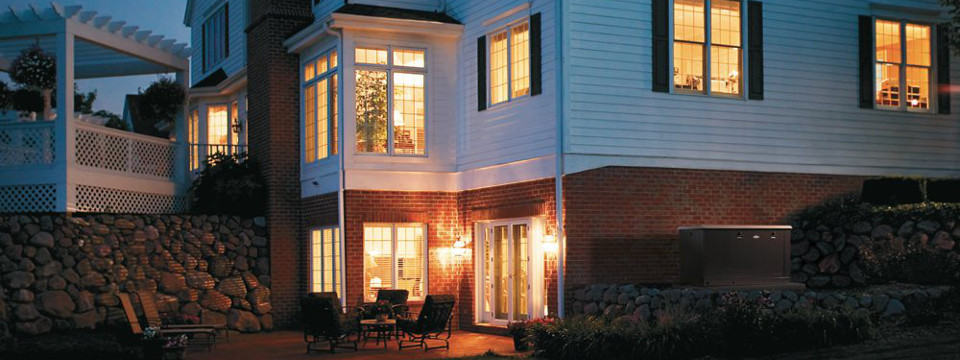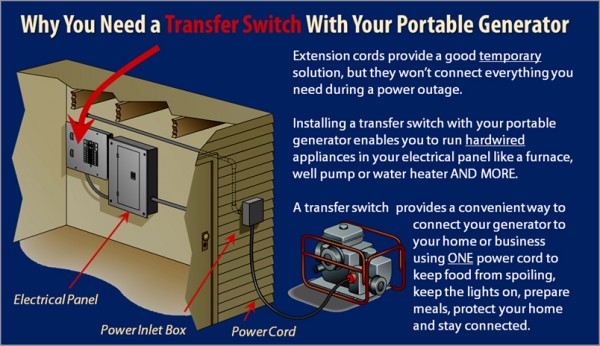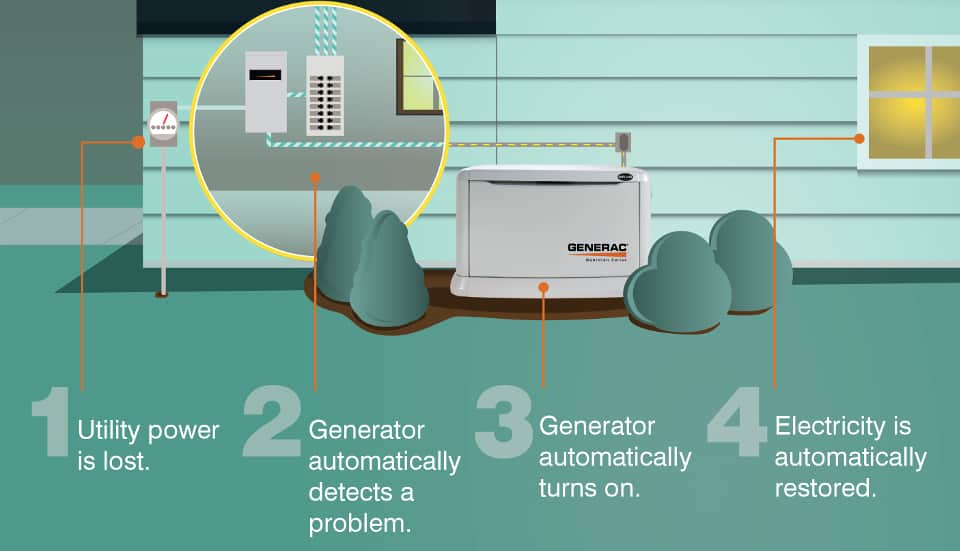The Benefits of Installing an Automatic Transfer Switch
Purchasing a power generator without installing an automatic transfer switch (ATS) is like paying for air conditioning or heat without a using thermostat. It doesn’t make much sense. An automatic transfer switch works similar to the way a thermostat operates, except instead of monitoring the temperature, it monitors the utility power supplied to home.

An Automatic Transfer Switch and Backup Power Generator Keep the Power on During Outages
You don’t need to know how to hook up a backup power generator to make these essential machines function. When the power goes out, the automatic transfer switch senses the loss and instructs the power generator to begin operation.
How Does an Automatic Transfer Switch Work?

A licensed electrician installs an automatic transfer switch between the generator and your home’s electrical circuits to supply electricity through the circuit breakers. The switch inside the ATS selects utility power or generator power. During the transfer of power from utility to generator, the utility connection is broken before the connection to the generator is made. The reverse is also true. This ‘break-before-make’ connection prevents generator power from backfeeding the utility lines and it also prevents the utility from damaging the generator.
Buyers Guide to Selecting the Right Automatic Transfer Switch
Some automatic transfer switches contain circuit breakers assigned to different loads in your home. For example, if your generator cannot carry the load of your entire home, but you want to keep your refrigerator and air conditioning running in case of emergency, a load center automatic transfer switch can supply your essential circuits during an outage.
Pro Tip: Install Whole House Surge Protection with your automatic transfer switch and generator. They protect everything in the house from power surges that slowly destroy the electronics in your computer, phones and tablets, and your major appliances.
Why Do You Need a Transfer Switch?
The installations of all power generators and automatic transfer switches are governed by the National Fire Protection Association and the National Electrical Code (NFPA & NEC) which requires homes with a power generator to have a transfer switch. However, the code only requires a transfer switch and does not specify either manual or automatic.
A transfer switch is the easiest way to power your home during an outage. It eliminates running extension cords to and from different appliances through walking areas, doors, and windows. Pinched cords and walking on cords are fire hazards. Routing extension cords through open windows, even just a crack, may allow carbon monoxide to enter the home. A transfer switch eliminates hazards and the inconvenience of extension cords while ensuring the smooth delivery of power to your home.

Automatic or Manual?
Norwall has a wide selection of transfer switches available to meet many different needs.
- Manual Transfer Switch: As the name suggests, a manual transfer switch requires someone to move the switch from the utility position to the generator position. They don’t work automatically with a power generator and can’t automatically manage high-voltage loads. Any power management is handled by the use.
- Automatic Transfer Switch: An ATS can automatically detect when power is lost. After the power generator starts and signals the ATS, it transfers the power source from the utility to the generator. It happens whether you are home or not and ensures critical circuits that power sump pumps, refrigerators and freezers, and heating and air conditioning function normally instead of not at all.
Frequently overlooked is the operation of generators during inclement weather. Using a portable generator during an outage requires someone going outside, setting up the generator, and routing extension cords or a generator cord, plus they have to start the generator—all in the correct sequence. Later, they will have to shut it down and let it cool to refuel. If it’s raining or snowing, the portable generator needs protection from the elements. Don’t operate them in the pouring rain or blowing snow.

An automatic transfer switch with a backup power generator eliminates all the hassle and worry. They operate in virtually any kind of weather and no one leaves the comfort of their home in the rain or snow to set them up. And they can power appliances such as your furnace or central air conditioner. Automatic Transfer Switches and Backup Power Generators work whether you’re at home or away. Remote management on smart phones, tablets, and laptops provides status updates, operating logs, and even scheduling maintenance or changing exercise cycles.
Manufacturers often bundle automatic transfer switches with their power generators. It’s one way to make a relatively easy decision about which model generator and ATS to purchase. Buying them as a bundle will reduce the cost and the included ATS is guaranteed to work with the generator.
The first step that many homeowners take determines how much power they need. Whether you want to power your entire home or just the essentials, check out Norwall’s Power Calculator to determine just how much backup power you need.
Looking for more information on Backup Power Generators? Check out Norwall’s Standby Generator Buyer Guide: What Size Generator do I Need?
Updated October 16, 2017
